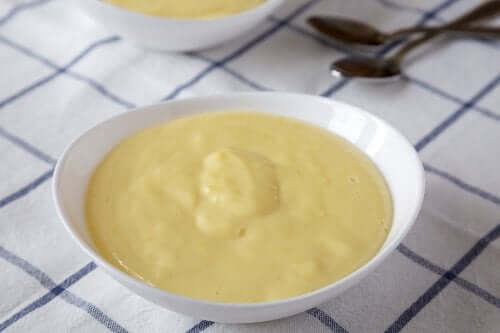2 English Desserts You Have to Try

Do you like English desserts? They have a long list of traditional, homemade recipes that remind us of the English countryside and grandma’s lovingly made desserts. The ingredients are classic, but the result is an authentic pleasure for your palate.
In this article, we’ll share two recipes for English desserts that you simply must try: summer pudding, a red fruit-based delight, and custard, a very versatile vanilla cream that can accompany anything sweet.
2 English desserts you have to try
1. Summer pudding

This dessert is very simple and will seduce anyone that sees it, thanks to the red fruits bathed in syrup. This delicious, good-looking dessert is one of the classics of English gastronomy that you can’t miss.
You can choose whichever red fruits you like, according to the season, or even freeze them and have them on hand all year. With these fruits you’ll fill this delicious pudding which opens like a surprise present letting you see the beautiful mixture of dark and light reds.
Ingredients
- 900 g (30 oz) of red fruits of your choice: strawberries, gooseberries, raspberries, cranberries
- 3/4 cup of white sugar (150 g)
- 7 slices of white bread (better if it’s a little hard)
- 1 teaspoon of vanilla extract (4 ml)
- 3 tablespoons of water (30 ml)
Read also: 7 Fruits and Vegetables that May Help Reduce Cancer Risk
Preparation
- First, wash the red fruits and let them dry.
- Then, in a large frying pan put 3 tablespoons of water with the sugar and heat until the sugar dissolves. Let it boil for 1 minute and then add the vanilla and fruits.
- Next, cook for 3 minutes on low heat, mixing lightly. You’ll see the fruits soften as they let out their juice.
- Let it cool, then drain the fruits, putting the liquid in a bowl.
- Off to the side, prepare the pudding mold and line it.
- After that, cut the crust off the slices of bread and wet them in the juice and put them in the mold, pushing them down well so you don’t leave any spaces.
- Then, add the softened fruits and cover them with the rest of the bread. In a separate bowl, save the leftover juice.
- Finally, put the lid on the mold and leave it in the fridge overnight.
- You can boil the leftover juice for 10 more minutes to reduce it and turn it into a delicious syrup.
- To finish, the next day you can serve the pudding. Add the syrup, and if you want, accompany it with ice cream or milk.
2. Custard

Custard is well-known as a typical creamy English dessert similar to flan. It’s light and a little sweet, and can be eaten by itself as a dessert or used to fill or accompany other desserts like tarts, cakes, etc.
We invite you to try this recipe and let yourself be seduced by its smoothness and delicate vanilla flavor. You don’t need many ingredients, and with some advice and cooking tips, the result will be perfect.
Read also: Recipes To Make A Delicious Spanish Orange Flan
Ingredients
- 2 1/2 cups of milk (675 ml)
- 4 egg yolks
- 1/4 cup of white sugar (50 g)
- 1 tablespoon of vanilla extract (10 ml)
- 2 tablespoons of corn starch (30 g)
Preparation
- To start, heat the milk and vanilla on low heat until it’s about to boil.
- To the side, mix the egg yolks, sugar, and corn starch in a bowl until you get a light-colored, smooth cream. Add a little of the milk to the mix and stir again.
- Then, add this mixture to the pot and mix well with the milk until it thickens like a custard.
- Next, strain the cream through a fabric strainer and save it in a container with plastic wrap to let it cool. The plastic wrap should be almost touching the cream to keep it from forming a hard layer on top.
- Now your custard is ready to eat by itself or with other desserts!
Do you like these recipes for delicious English desserts? Why not prepare the delicious summer pudding and accompany it with the smooth and creamy English custard? They make an excellent combination that your whole family will love!
All cited sources were thoroughly reviewed by our team to ensure their quality, reliability, currency, and validity. The bibliography of this article was considered reliable and of academic or scientific accuracy.
- Mazzoni, L., Scalzo, J., Di Vittori, L., Mezzetti, B., & Bottino, M. (2017). Berries. In Fruit and Vegetable Phytochemicals: Chemistry and Human Health: Second Edition. https://doi.org/10.1002/9781119158042.ch41
- Joseph, S. V., Edirisinghe, I., & Burton-Freeman, B. M. (2014). Berries: Anti-inflammatory effects in humans. Journal of Agricultural and Food Chemistry. https://doi.org/10.1021/jf4044056
- Lim, T. K. (2012). Vanilla planifolia. In Edible Medicinal And Non-Medicinal Plants. https://doi.org/10.1007/978-94-007-4053-2_13
This text is provided for informational purposes only and does not replace consultation with a professional. If in doubt, consult your specialist.








